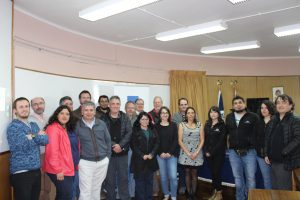National and international experts discuss loco current status.
August 18th, 2019On August 12th and 13th , at Universidad Catolica de Valparaíso Marine Sciences School, a team of national and foreign professionals gathered to share their research cocerning loco (Concholepas concholepas).
The activity was organized by the Oceanography and Environment Department from the Fisheries Development Institute (IFOP) Management Areas Section . The workshop aimed to analyze locust resource status of knowledge emphasizing on connectivity between management areas along chilea coast.
Gabriel Jerez from Fisheries Undersecretariat, noted the economic importance of the conservation of this resource sustainability for many of the artisanal fishermen communities in Chile. Dr. Leyla Cárdenas, from Universidad Austral de Chile, showed both, similarities and differences presented by the specie present through genetic techniques throughout Chile: “we have been investigating the resource for 15 years, in a first stage we began to identify locust species, after many years of work we managed to identify that there is only one kind of locust, which is a virtue of the species that has managed to maintain in its cohesive evolutionary history as a single specie in an environment as variable as Chile ”. These tools could help to perform resource’s traceability by discouraging illegal fishing as well as repopulation programs evaluation.
On the other hand, Dr. Lysel Garavelli from the Pacific Northwest National Laboratory showed the results of a biophysical model implementation and how simulations give us the first approximations of connectivity between areas. Dr. Garavelli noted that “it uses hydrodynamic models; that allow to see temperatures, currents, speed and currents directions. The research results show us that the larvae move with sea currents up to 200 km ”
Dr. Patricio Manríquez from Arid Zones Advanced Studies Center, CEAZA, showed the progress made in analyzing these populations displacement using stable isotopes. Dr. Manríquez pointed out that “it is necessary to establish what happens in the sea with locust larvae displacement, since they have rhythms of activity, they have the ability to go up and down in the water column, to respond to temperature, presence of food and therefore these traits have to be considered when studying locust resource ”
Luis Ariz, head of management areas section, explained the importance of strengthening the “Fisheries Monitoring Program Under Management Areas Regime” that is part of the project portfolio of the Performance Agreement of the Undersecretariat of Economy (MINECON) and the Advisory for decision-making in Fisheries and Aquaculture (ASIPA) carried out by IFOP. This program has set national technical standards for the direct evaluation of this and other benthic resources and is taking up the path of developing basic and applied scientific knowledge as a basis for the recommendation of management decision making.
The workshop’s main conclusions show the need to move forward with new, though expensive, techniques such as genetics, modeling and Isotopes to answer old questions and consider that knowledge gaps in the life of this organism require more basic research. ”
Dr. Jaime Letelier, IFOP, oceanography and environment department head referred to the workshop as “a significant advance in tnew available knowledge review , new techniques and gaps that must be addressed through basic scientific research, especially considering aspects as varied as the contamination by coastal edge floating plastics or light pollution that alters the organisms life cycles, indicated by Dr. Manríquez, as well as the climatic change new context which involves temperature increase and ocean acidification that without doubt alter the physiology and habitat in our locust sensitive life cycle ”.

